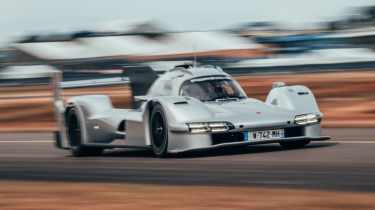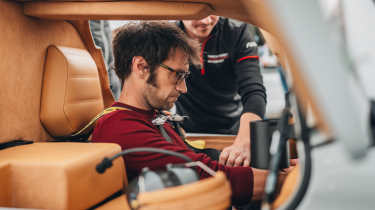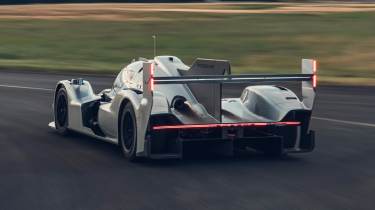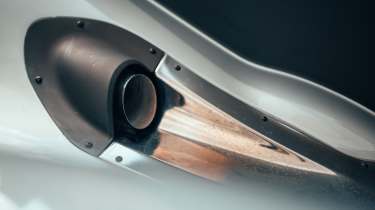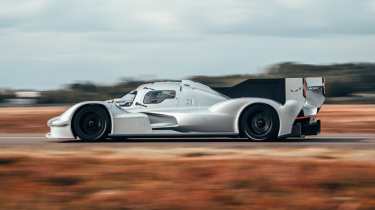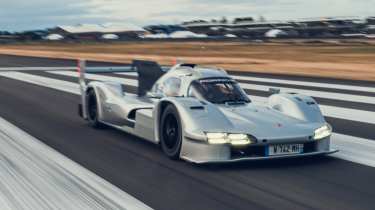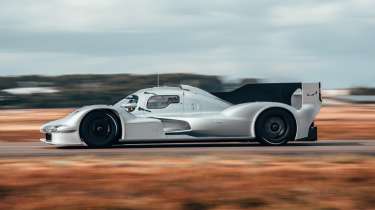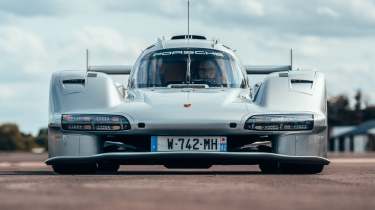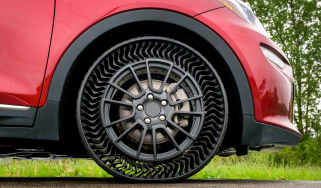Porsche 963 RSP 2025 review – driving the ultimate one-off Le Mans racer for the road
That the 963 RSP even exists is absurd. Driving it felt like a fever dream
Are you the sort of person who goes to the local aquatic centre to stock up the garden pond and, when presented with the choice of koi or sturgeon, asks the assistant if they have anything more in the orca category? Are you the sort that deems an extinguisher in the kitchen a bit lightweight, so keeps a Dennis Rapier parked outside, just in case? If so, you probably look at a 911 GT3 RS with its towering rear wing and still think there’s just a bit too much road and not enough racer for an exciting jaunt round the NC500. In which case you need a Porsche 963 RSP – a genuine, road-converted Le Mans Hypercar.
You can’t have one I’m afraid, because the sole example belongs to The Captain, Roger Searle Penske – the RSP in the car’s name. Owning Indianapolis Motor Speedway, IndyCar and the Porsche Penske Motorsport team has to have its perks. But in order to determine if you’d want one in your fantasy garage, I was allowed to have a brief stint behind the wheel (with Le Mans airport standing in for the Mulsanne) to get a taste of what it’s like.
As with so many of the best things, the 963 RSP originated not from an official boardroom brainstorm but a chat and a bit of ‘what if’ at a race meeting. That race meeting wasn’t years ago, either; it was Petit Le Mans at the end of the 2024 season, so development has been almost as fast as the car.
The need for a quick turnaround and the trigger for the original conversation was the 50th anniversary of another road-converted Porsche Le Mans car: 917 chassis number 30, which was owned by Count Rossi of Martini & Rossi Vermouth fame and fortune. That car originally raced in Austria in 1971, when it qualified third and was running well before a suspension problem put it out of the race. Then it went back to the factory to help with ABS development before being released onto the public highway in 1975 with 600bhp, a horn, a Hermès interior and a spare wheel.
More reviews
Group tests
- Lotus Emira Turbo SE v Alpine A110 GTS – two of the last surviving mid-engined sports cars
- Alpine A290 v Alpine A110 – how much DNA do they really share?
- Ariel Atom 4R v Caterham Seven ‘evo25’: power-to-weight heroes go head-to-head
- Ariel Atom 4 v Caterham Seven 310R v Lotus Elise Cup 250
- £200,000 supercar shoot-out: AMG v Aston Martin v Maserati v McLaren
- Audi Quattro, RS2 and RS3: five-cylinder icons head-to-head
- Who makes the best GT car? Aston Martin v Bentley v Maserati
- Caterham Super Seven 600 v Super Seven 2000
- Corvette Stingray v Porsche Cayman GTS v Audi R8 RWD
- Great Ferrari hypercars driven: 288 GTO, F40, F50 and Enzo head-to-head
In-depth reviews
- Abarth 600e 2025 review – Italy gives the Alpine A290 something to worry about
- Alpine A110 review – the sports car Lotus should be building
- Aston Martin Vantage 2025 review – a thrilling Mercedes-AMG GT and 911 Turbo S alternative
- Audi R8 (2015 - 2024) review – the ultimate soft-focus supercar
- BMW iX 2025 review – the ugly duckling still stomps the Tesla Model X
Long term tests
- Abarth 695C Turismo Fast Fleet test – living with the charming Italian hatch
- Alfa Romeo Giulia Veloce long term test – can Italy beat Germany?
- Alpina B10: Alpina B10: end of term report
- Aston Martin Vantage (2006) Fast Fleet test – living with a £30k V8 Aston
- Caterham Seven evo25 Fast Fleet test – living with a track car for the road
- Caterham Seven evo Edition revealed – bespoke 420R joins the Fast Fleet
- Cupra Leon 300 Fast Fleet test – living with Spain's 300bhp hot hatch
- Cupra Ateca VZN Fast Fleet test – four months with Cupra's hot crossover
- Cupra Leon Estate 310 4Drive Fast Fleet test – living with the 306bhp hot estate
- Ford Mustang GT
Review
- New Bentley Batur 2023 review – can it possibly be worth £1.65m?
- 2023 Chevrolet Corvette C8 Z06 review – the American 911 GT3?
- BBR Supercharged Mazda MX-5 (ND) 2023 review – tuned 250bhp roadster driven
- MG4 Trophy 2023 review
Reviews
- Abarth 695 75 Anniversario edition 2024 review – a fitting send-off for Abarth’s hot supermini?
- Abarth 500e 2023 review
- AC Cobra 378 Superblower MkIV 2021 review – another V8 Cobra, but with a GM heart this time
- Acura Integra Type S 2024 review – a Honda Civic Type R with added restraint
- Alfa Romeo Giulia 2025 review – get one while you still can
- Alfa Romeo 33 Stradale 2025 review – a rare Italian jewel beyond compare
- Alfa Romeo SZ: history, review and specs of an icon
Count Rossi’s idea of a shakedown drive was a 400-mile jaunt from Weissach to Paris, during which the Porsche wore Alabama number plates. Even though it was the free and easy 1970s, both the German and French authorities had shaken their heads when asked to rubber-stamp it for the road, but Alabama agreed to register it on the understanding that it would never actually be driven in the state, which seems to be either very mischievous or a particularly mendacious type of NIMBYism. Today the car is still in private hands and has recently undergone a sympathetic restoration so that it can continue to be used on the road and enjoyed as Count Rossi intended, which is rather wonderful. And clearly inspiring.
Timo Resch (president and CEO of Porsche Cars North America) has been a significant driving force behind the 963 RSP, and much of the work on the car was done at PCNA HQ in Atlanta, which is the only place outside of Germany that carries out official full factory restorations. In close collaboration with Stuttgart and Penske, the project moved swiftly, with as small a team as possible involved. There was a feeling that at some point someone might well put an insurmountable barrier in the way by uttering something like ‘you want to do what?!’ but to everyone’s surprise it never happened.
And now it exists. Underneath the RSP is a brand new chassis from Multimatic, identical to that of the 963 race cars. The DSSV spool-valve dampers have been set to their softest tune and the ride height raised as much as possible within the limits of the double-wishbone pushrod suspension, although it still looks lower than a snake on a stake-out. The wheels remain 18-inch forged OZ racing rims and the tyres are treaded wets, albeit with bespoke 1970s Michelin logos on the sidewalls.
The 671bhp hybrid powertrain is also fundamentally the same as you’ll find in any of the 963s lining up on a grid. That means a 90-degree, 4.6-litre, twin-turbo V8 that can trace its lineage back to the RS Spyder race cars that Penske ran so successfully in the American Le Mans Series in ’06, ’07 and ’08. Back then the V8 was 3.4 litres in capacity and naturally aspirated. It was then enlarged to 4.6 litres and used in the 918 Spyder road car before gaining light-pressure turbos from Dutch company Van der Lee and a bit of strengthening (so that it could become a structural member) for the 963.
For the RSP, the combustion engine has been modified to run on pump fuel (not the work of a moment, apparently, despite its lineage) and the ECU has also been remapped to give a little more smoothness to the power delivery. The 1.35kWh battery is from Williams Advanced Engineering and the rest of the hybrid components, such as the motor generator unit, are from Bosch. Xtrac supplies the seven-speed, pneumatically actuated sequential gearbox.
To match the 917, the RSP has been clothed in an identical PTS shade of Martini Silver, though unlike the race cars, which are wrapped, the RSP’s Kevlar and carbon bodywork has been painted. It also gets a proper enamel badge on the nose and a bespoke 963 RSP badge on the back.
The difference the colour makes is actually one of the most striking things about the car. It’s a bit like racing drivers’ helmet designs, because where once they were simple and clear, now they’re complicated and somehow less striking. Similarly, modern race car liveries are often so busy or even designed to disguise that it’s hard to take in the overall shape of the vehicle.
As such, it’s lovely seeing the 963 RSP in just one colour. The 963 isn’t an instantly pretty shape like the simple, singular form of the 917, but it is surprisingly attractive in the way that its bodywork flows from front to back, clinging closely to the hard points beneath. Even at a standstill it looks as though it has been carved by a prevailing wind over millennia, with intriguing voids and a mixture of sharp and rounded edges. Leaving the shark fin in black really helps the overall appearance, too, accentuating the sleek sweep of the cockpit.
On the race cars, the arches are left open above the wheels in order to let the air escape and help prevent a repeat of the famous Dumbreck/Webber flying car incidents. Clearly a road car can’t have the wheels open like this, so 3D-printed panels have been designed with louvres like those on the 917. Conversely, at the back of the car a couple of aerodynamic panels have been removed so that anyone following the RSP can see the full height of the rear tyres, again, like the 917.
Getting in is a little bit like automotive spelunking, with the need to sit on the sidepod and then post your legs through a small opening down towards an unseen pair of pedals in the small dark recess beyond the seat. Once the rest of you has twisted and slithered in behind, it’s actually rather comfortable with your bum low and your feet high. There is the snugness that you would expect given the confines of the cabin (it’s a cockpit made for one, despite the space to your right) but there is also a softness thanks to the leather and Alcantara trim. What also hits you and feels totally alien in any modern race car is the rich, heady smell of the hides.
The light colour of the 917-matching tan trim really helps make the cockpit feel less intimidating once you’re ensconced, as does the removal of the FIA-sanctioned head restraints. Apparently when the carbonfibre spars and bars were removed, there was one left – and that is how the cup holder came about. The initial thought was to turn it into a phone holder, but the cup holder was deemed a little more whimsical and in keeping with the sense of fun that runs through the whole project.
Also in this vein are the 3D-printed vents that mimic the famous fan on top of the 917’s flat-12. I think things like this are easy to dismiss as fripperies but they actually help cement the character of the car and the ethos behind it. The project isn’t just about the dry practicalities and potential PR of making this run on the road, it’s a bit of fun. Looking out through the dramatically curved windscreen at the gleeful, almost child-like smiles on the faces of Resch and the handful of engineers in attendance, you can’t fail to understand how the project has made it this far.
Matching leather-trimmed headset on and listen to the instructions from the voice coming through the cans. Ignition toggle. Hybrid toggle. Then find the pitlane speed limiter from amongst the rainbow of buttons and switches on the steering wheel in front of me – right thumb, green. Pull either one of the clutch paddles, which are the lowest of three on each side of the back of the wheel. Select first gear with the middle right-hand paddle – a satisfyingly positive click. I’m now primed and ready, but the engine isn’t running at this point.
With the clutch paddle pulled towards me, I can simply squeeze the accelerator and move off, almost silently, under electric power alone. There’s just a background whirr, which is hard to even hear through the headset, and that makes what happens next all the more shocking. At 45kph (28mph) a blue box on the lower edge of the steering-wheel screen flashes up with the words ‘Bumpstart ready’ in white letters. Now you can release the clutch paddle. Not slowly. Not gradually. Not tentatively. Just dump it.
Noise suddenly explodes into the cabin and you feel the V8 come to life behind your back with a jolt. It’s shocking the first time, but the abruptness of a bump-start with no starter-motor preamble is somehow joyous. Maybe it’s because a bump-start usually follows a breakdown of some description, so the association is with a start of more significance than usual. Whatever it is, there is something wonderfully theatrical about it.
Pit limiter off and unleash the full fury of the gruff, guttural engine, watching for the lights on the top of the steering wheel that illuminate green, yellow, red and then flash blue to tell you to shift at around 8000rpm. Belted in securely and sitting in a chassis that feels more than able to handle the power, the acceleration is enjoyably punchy rather than utterly unhinged. I don’t want to downplay it, but the RSP makes 650bhp per ton feel quite manageable.
The AP Racing carbon brakes are unchanged from the race car, which sounds like a recipe for disaster in something that is meant for the road. However, because there is regenerative braking to add into the equation on the rear axle, the whole system is brake-by-wire, which may explain why there are no nasty surprises when I hit the left pedal towards the end of the tarmac. It feels perfectly natural, with just progressive, easily modulated stopping power.
As the speed drops below 45kph you have to remember to dip the clutch with your fingers so that the engine idles and you return to electric propulsion (albeit with a rumbling V8 accompaniment) for the slow-speed stuff. Then you can dump the clutch again as you accelerate.
> Ferrari F80 2025 review – near-1200bhp tech tour de force tested on road and track
Perhaps the most unexpected thing about the 963 RSP is the steering. As I head back down the taxiway, I create my own imaginary slalom and discover a wheel with genuine weight and feel. It’s Porsche steering. The button-festooned, paddle-backed carbon creation I’m holding might be a world away from the 360mm-diameter circle in a GT3, but close your eyes (I didn’t) and there would be familiarity right there in the palm of your hands.
So often in race cars, the feedback doesn’t materialise until you’ve got real load going through the car, but even at a sedate pace the RSP gives you feedback and confidence (it’s no surprise to find out later that the steering is hydraulically power-assisted rather than EPAS). As a result I get a bit braver with the speed and very quickly I start to think that the RSP might actually be quite fun on a trackday or even out on the road.
It’s wickedly responsive, as you’d expect of a race car weighing a little over 1000kg, but not flighty. You can really sense the car underneath you, and with a little bit of roll from the raised ride height and a bit of squirm from the treaded tyres you have a good sense of connection to all four corners of the car. Because you can clearly feel the loadings and how the weight is transferring it doesn’t feel like it’s going to surprise you.
Some of this has obviously been dialled in with the adoption of the aforementioned ride height and the soft dampers, but I think much of it is inherent in the 963. You just need to watch the way the factory drivers grab it by the scruff of the neck and slide it around in races; it doesn’t look like a twitchy, knife-edge sort of race car.
> Pagani Huayra Codalunga v Huayra Roadster BC – £10m of hypercar siblings go head-to-head
Perhaps the ultimate example of this was in Kévin Estre’s pole lap at Le Mans last year. On his final attempt, the Frenchman hung it all out and snatched the quickest time from under the nose of Alex Lynn. He was on the ragged edge. Watch the onboard through the Dunlop chicane – he basically backs it in. There is also a fantastic slow-motion exterior shot of him sliding through the final chicane, crossed-up and attacking the kerbs like he’s in a rally car on a Super Special. It’s a beautiful bit of car control and apparently that’s how the car likes to be driven.
Clearly I am no Kévin, but nonetheless that lap made more sense after driving the 963 RSP and feeling the confidence the steering gives you and the way the car really seems to be understandably underneath you. The race car looks like fun to drive and in my brief time behind the wheel the RSP felt like fun to drive too.
Could you take it down the Route Napoléon? From a visibility standpoint I think you’d cope on the road. The view out is intimidating when you first get in, but once on the move it was better than I’d expected, and although I’m not usually a fan of digital rear-view mirrors, in this instance it was a welcome addition. At fully 5m long and 2m wide, the RSP is a big car, but the prominent front arches make it easy to place and the fabulous steering gives you confidence.
Low-speed stuff is obviously a doddle because you’re just driving on electric power, so there is no juggling of a clutch as you pull away. The turning circle would be the trickiest thing to manage because it’s limo-like in its sweep and you need to remember to keep one or other of the clutch paddles pulled in as you wind on the lock. However, I suspect that with a bit of practice you could get the knack of spinning up the rear tyres to tighten the radius.
> GMA T.50 v McLaren F1 – has the best car in the world been dethroned by its successor?
Of course, given that there was an engineer standing nearby with a laptop when the RSP was starting up, I don’t think a spur-of-the-moment Sunday morning blast would be feasible unless you had a certain amount of technical know-how. But talking to Timo Bernhard, who had driven the car through sometimes rainy towns and villages, along the autoroute and down country roads, the car coped just fine with the sort of road furniture that you might have thought would trip it up.
In the hours and days after driving the 963 RSP, I spent some time thinking over past experiences, trying to compare and contrast. The Mercedes CLK GTR and the Aston Martin Valkyrie were the cars that came to mind as most closely resembling the Porsche, with their extreme road-racer vibes, small upward-hinging doors, all-consuming noise and Le Mans connections.
My initial thought was that the Valkyrie in particular becomes even more impressive in light of the RSP, because it is to all intents and purposes as extreme, yet is fully homologated. But on the flip side, the Aston and the Mercedes had their roadworthiness baked-in from the outset, whereas until last October, with two seasons of racing under its belt, nobody had given any consideration to trying to put a 963 on the road. I think quite a few of us wondered if Porsche might do something similar to the track-only Ferrari 499P Modificata at some point (and maybe they still will), but not a car with number plates.
Clearly this one-off is not a fully homologated car. It has been road-converted but not road-registered, with special permission being granted by the French authorities and the EPA in the US. Which means it is also not the much-anticipated follow-up to the 918 Spyder as some had perhaps hoped. But could it be?
Before I drove it, I loved the story and the fact that it existed but was fairly sure it would feel preposterous as a road car proposition. Now that I’ve had a go, I’m not so sure. With a little more time and a few more alterations… maybe? Some might say that 671bhp isn’t enough in this day and age, but combined with such a light kerb weight I think it is pretty compelling. See the GMA T.50 for further evidence.
Or perhaps it is best left as part of a now fabulous pair. A brilliant golden anniversary tribute to a wonderful original. I wonder what we’ll see in another 50 years?

